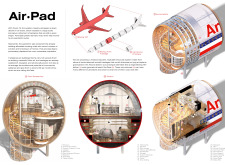5 key facts about this project
Sustainable Adaptation and Modular Design
One of the key aspects of the Air•Pad project is its use of aircraft fuselage sections, which possess inherent structural integrity, insulation properties, and waterproof characteristics. By cutting the fuselage into segments, the design allows for easy scalability, making it viable for mass production. This modularity enables the creation of several housing units from a single aircraft, optimizing resources and space in urban areas.
The interior layout of each Air•Pad seamlessly integrates functionality with comfort. The design includes a kitchenette, workspace, bedroom, and social lounge, allowing for a comprehensive living experience within a compact footprint. The vertical circulation features a spiral staircase, which maximizes floor area while allowing ease of movement through multiple levels. Sustainable elements, such as double-glazed glass for natural light and ventilation, enhance the livability of these micro-units.
Innovative Use of Materials
The project's materiality is significant. Externally, stainless steel and aluminum provide durability and a modern aesthetic, while exposed wood finishes introduce warmth. This combination of materials creates a unique juxtaposition of industrial and residential characteristics, appealing to diverse demographics. Additionally, the integration of energy-efficient appliances and potential solar panel installations reflects a commitment to sustainability and reduced ecological footprints.
Air•Pad intersects the themes of reuse and urban housing, elevating the narrative of affordable living spaces by infusing aircraft technology into the residential domain. The focus on modularity, adaptability, and resource efficiency sets Air•Pad apart from conventional housing solutions, providing a forward-thinking framework for the future of urban dwellings.
For a deeper understanding of the Air•Pad project, including architectural plans, sections, and overall design ideas, readers are encouraged to explore the project's presentation and examine the intricate details of this innovative architectural endeavor.























